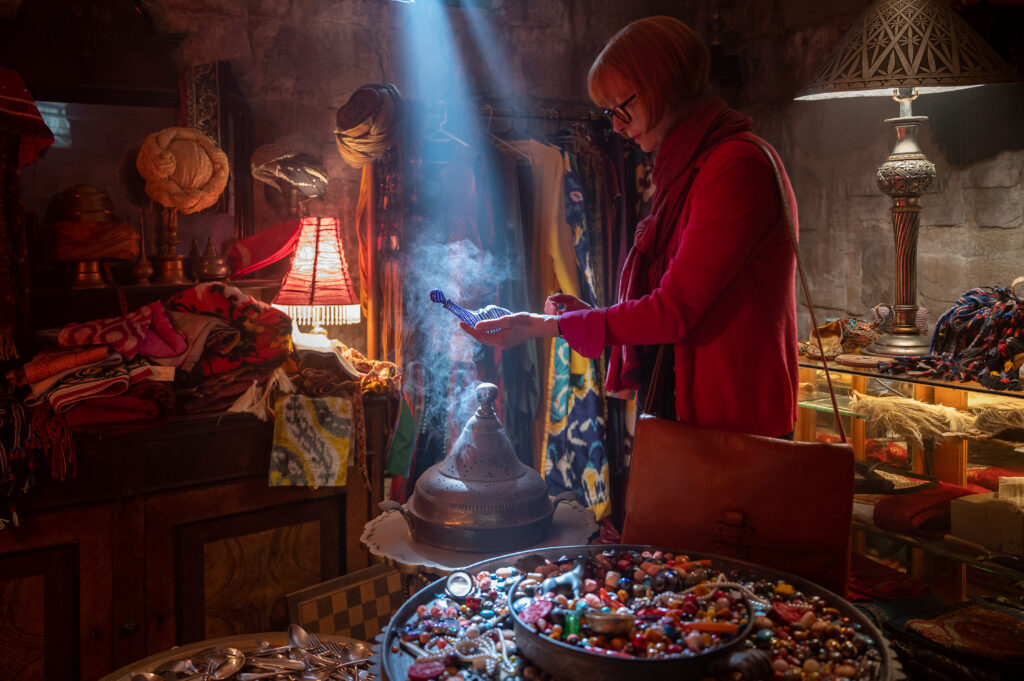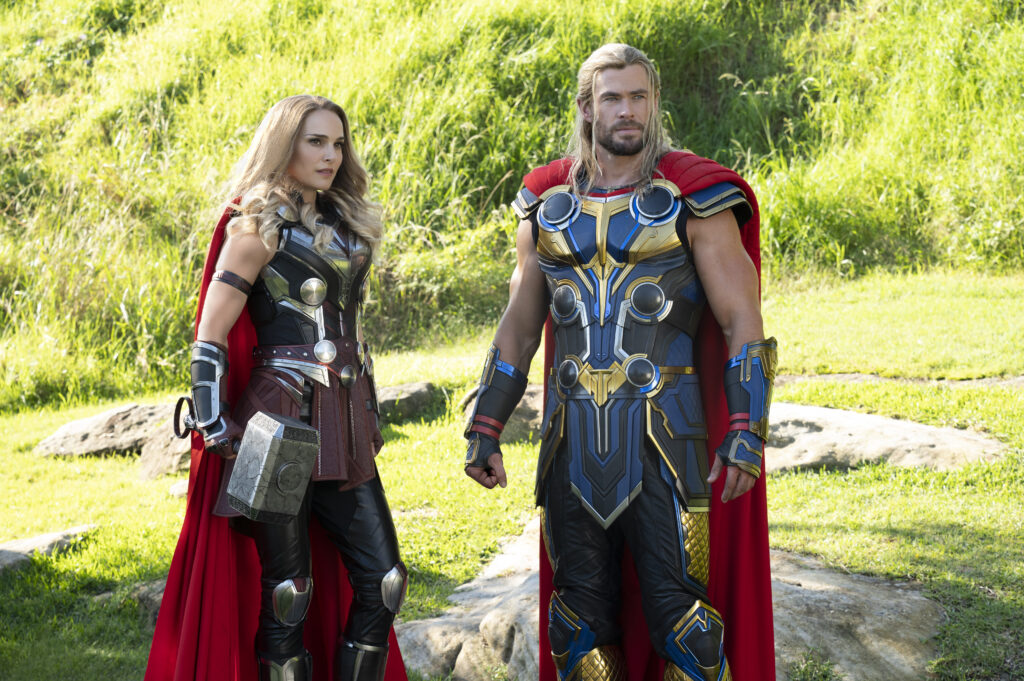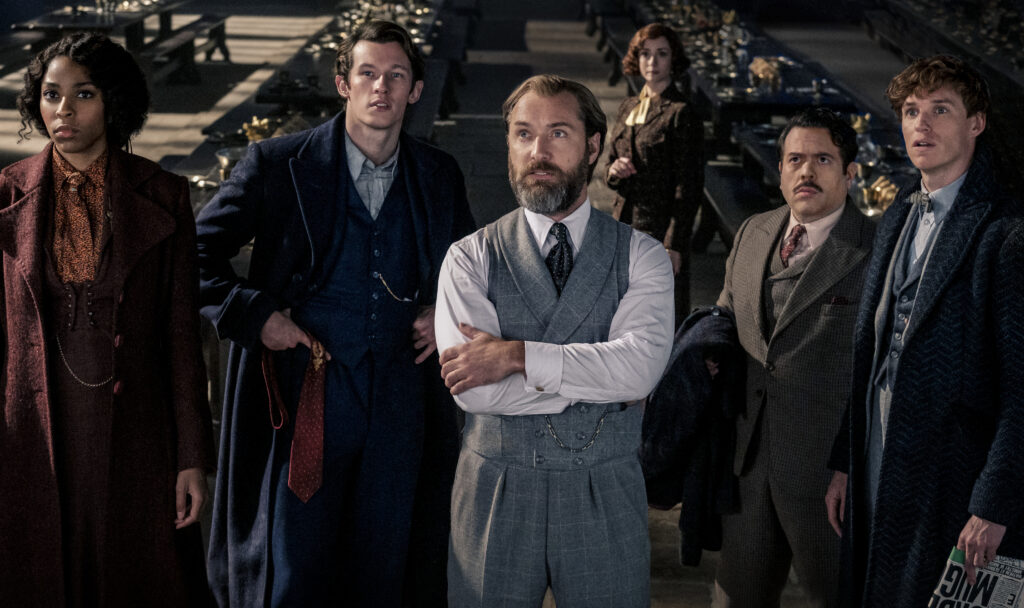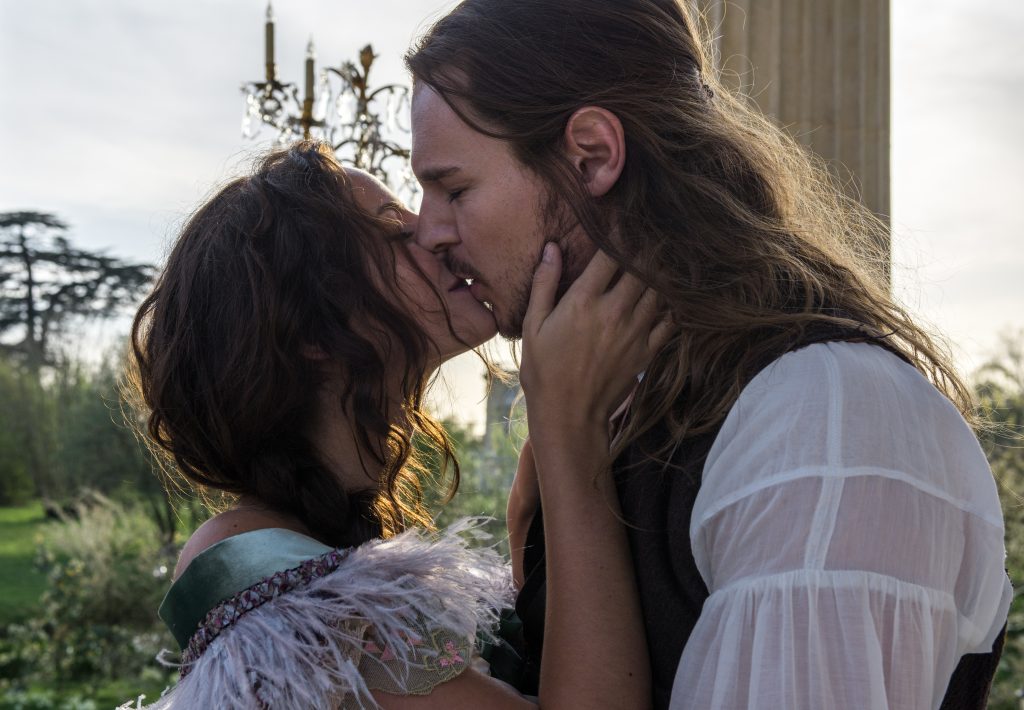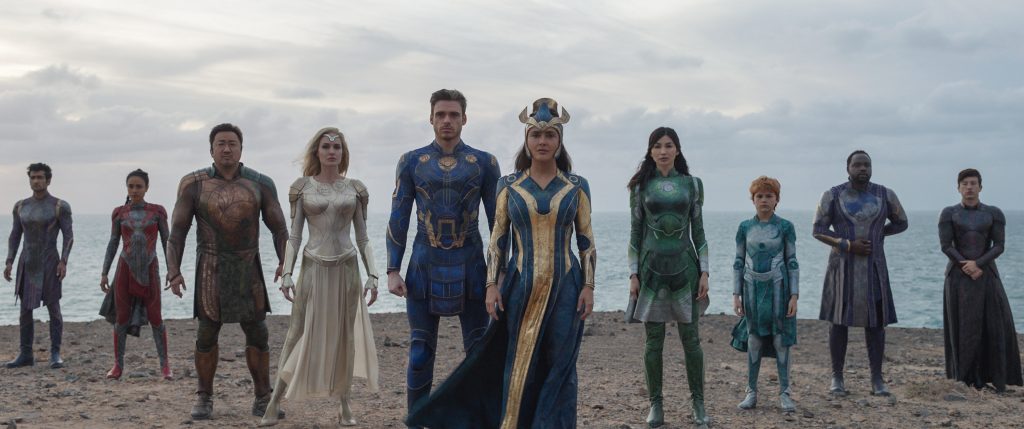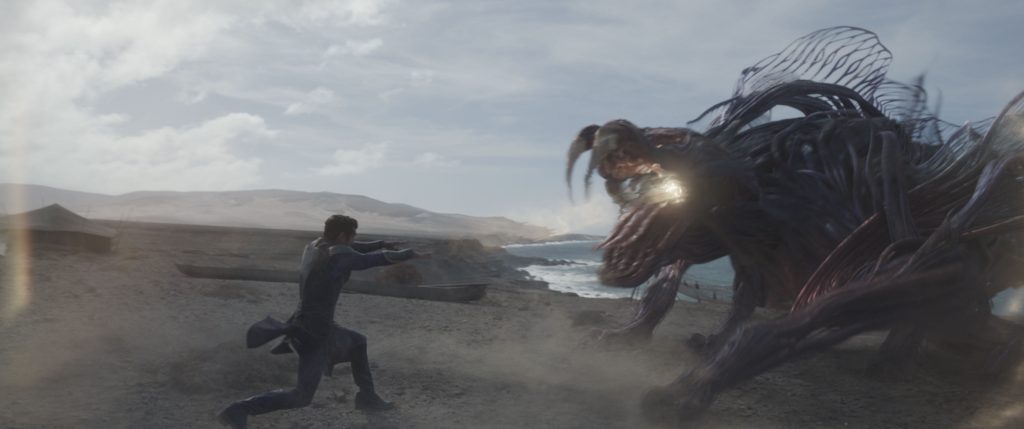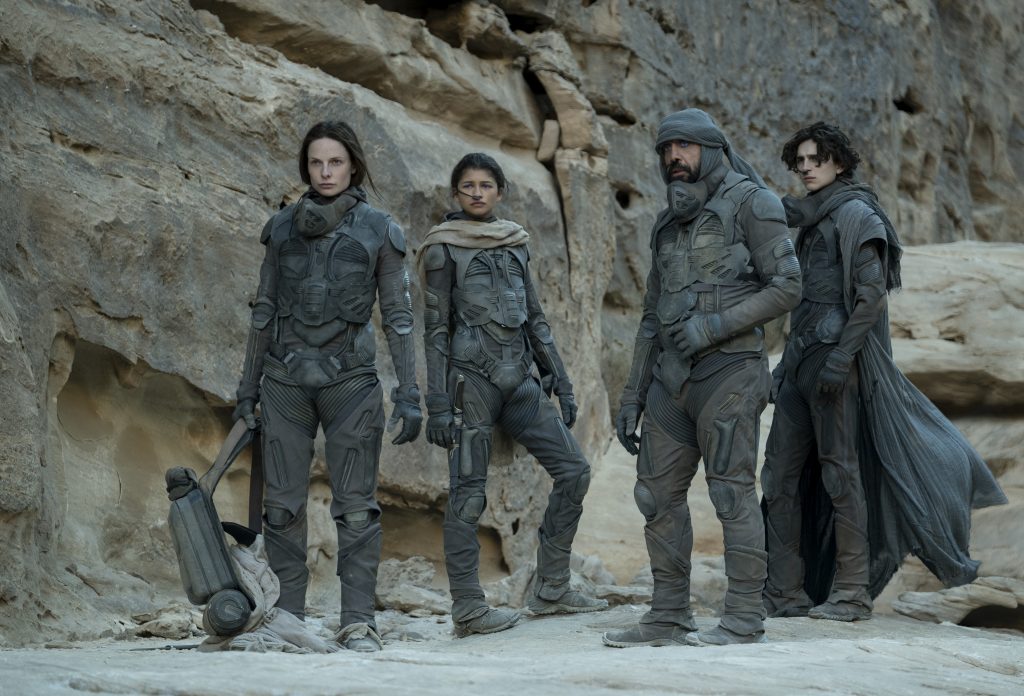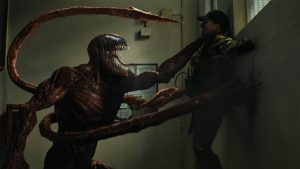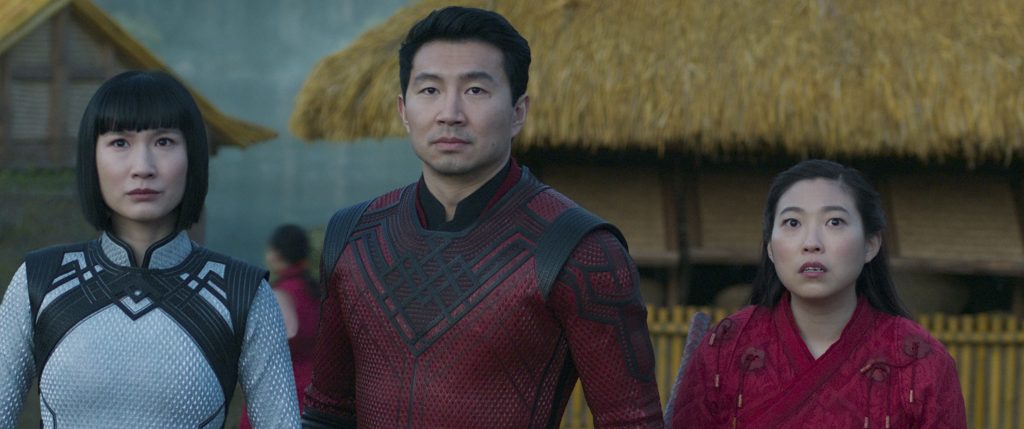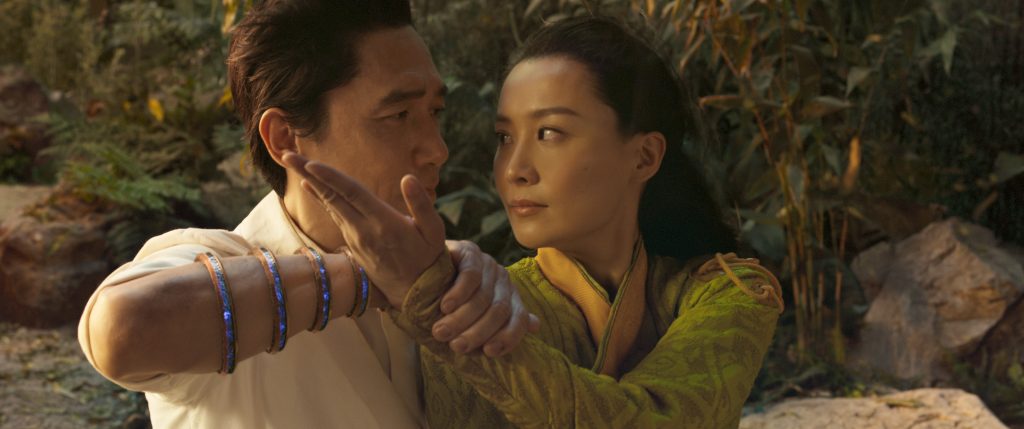September 29, 2022
by Carla Hay

Directed by Anne Fletcher
Culture Representation: Taking place in Salem, Massachusetts, the fantasy comedy film “Hocus Pocus 2” features a predominantly white cast of characters (with some Latinos and African Americans) representing the working-class and middle-class.
Culture Clash: In this sequel to “Hocus Pocus,” the Sanderson witch sisters return to wreak more havoc on Salem.
Culture Audience: “Hocus Pocus 2” will appeal primarily to people who are fans of the movie’s main stars and the original 1993 “Hocus Pocus” movie, but fans should keep their expectations low, since “Hocus Pocus 2” delivers a very forgettable and middling story.
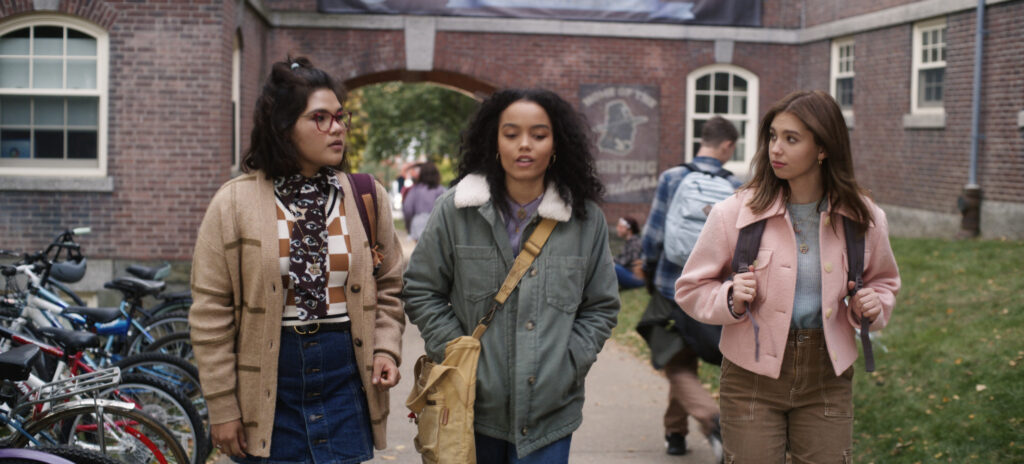
The magic of a classic film is missing from “Hocus Pocus 2,” which lacks much of the charm and adventure of 1993’s “Hocus Pocus” movie. The chase scenes are tepid, the performances are inferior to the original movie, and the witches show no real danger to the kids. “Hocus Pocus 2” plays out like a lazily conceived TV special (including annoying sitcom-ish music) instead of a cinematic event, which is why “Hocus Pocus 2” was released directly to Disney+ instead of movie theaters first.
Directed by Anne Fletcher, “Hocus Pocus 2” suffers from sequel-itis: when a sequel doesn’t do anything to improve on the original project. Because it took 29 years to release a sequel to “Hocus Pocus,” this sequel-itis problem is harder to forgive for “Hocus Pocus 2,” because there’s been plenty of time to come up with better ideas for a follow-up to “Hocus Pocus.” The more experienced cast members of “Hocus Pocus 2” perform better than the less-experienced cast members, but that’s not saying much when the movie’s unimaginative screenplay from Jen D’Angelo drags the movie down a lackluster and frequently boring path.
The original “Hocus Pocus” movie is not a great film, but it gained a cult following and has since become a Halloween classic for a lot of people, just like 1983’s “A Christmas Story” (another mediocre movie) gained a cult following and became a beloved Christmas film for a lot of movie viewers. The story in “Hocus Pocus 2” gets distracted by a lot of teen angst about who is and who isn’t in certain cliques in high school. “Hocus Pocus 2” has too many filler scenes that make it look like about 40 minutes of this 103-minute film could have been removed, and this editing wouldn’t have made a difference at all to the movie’s underwhelming conclusion.
In the first “Hocus Pocus” movie (which was set in 1993), 15-year-old Max Dennison (played by Omri Katz) and his 8-year-old sister Dani Dennison (played by Thora Birch) have recently moved with their parents from Los Angeles to Salem, Massachusetts. Max and Dani hear about the Salem legend of three witch sisters—Winifred Sanderson (played by Bette Midler), Mary Sanderson (played by Kathy Najimy) and Sarah Sanderson (played by Sarah Jessica Parker)—who were known for eating children and were hanged to death by Salem residents in 1693. Ever since, Salem has been under threat of the possibility that the spirits of the Sanderson witches could return to get revenge and to kill more children.
Winifred, the eldest Sanderson sister, is bossy and mean-spirited. Mary, the middle sister, is nervous and eager to please “alpha witch” Winifred. Sarah, the youngest sister, is ditzy and very flirtatious. As legend has it, Winifred poisoned to death a man named William “Billy” Butcherson (played by Doug Jones) in 1693, because Billy was caught kissing Sarah, even though Winifred claimed Billy was her boyfriend. In “Hocus Pocus,” the Billy character was resurrected from his grave as a zombie.
The only way that the Sanderson sisters can come back to life is on Halloween, during a night with a full moon, and if someone lights a special black candle and chants a certain spell. The Sanderson sisters have a big book of spells called the Manual of Witchcraft and Alchemy that is actually “alive” (the book has one eye that can open and shut), and the sisters want to get possession of this book when they are resurrected. However, these witch sisters can be stopped when the sun comes up before they can cast the ultimate spells that they want to cast.
In “Hocus Pocus,” a skeptical Max, who doesn’t believe in magic, accidentally brings back to life the Sanderson sister witches, who then kidnap Dani. Max teams up with a classmate (and his secret crush) named Allison Watts (played by Vinessa Shaw) to try to rescue Dani. “Hocus Pocus” is very predictable, but it has plenty of amusing and adventurous moments.
In “Hocus Pocus 2” (which takes place in Salem in 2022), the witches are brought back to life on purpose by two best friends named Becca (played by Whitney Peak) and Izzy (played by Belissa Escobedo), who conjure up the Sanderson Sisters on a moonlit Halloween night that happens to be Becca’s 16th birthday. There’s also an adult character who wants the witches to be brought back to Salem. This conjuring scene doesn’t happen until about 30 minutes into the movie.
Instead, “Hocus Pocus 2” begins with tedious flashback scenes showing the Sanderson sisters as girls who are about 11 or 12 years old, sometime in the late 1600s. Taylor Henderson has the role of Young Winifred, Nina Kitchen performs as Young Mary, and Juju Journey Brener is the character of Young Sarah. None of this backstory amusing, interesting or well-acted.
The only real purpose of this drawn-out flashback is to show that the Sanderson sisters’ main nemesis back then was a judgmental pastor named Reverend Traske (played by Tony Hale), who has told Winifred that she’s getting old and has arranged for her to marry a young man named John Pritchett (played by Thomas Fitzgerald). The movie makes a point of showing that back in the 1600s, when human beings’ life expectancies were much shorter than they are now, pre-teen girls could get married and had marriages arranged for them by elders in the community.
However, Winifred doesn’t want to marry John, because she has her sights set on young Billy (played by Austin J. Ryan) to be her future husband. Winifred also defies and insults Reverend Traske by taking the Lord’s name in vain. With a crowd of Salem residents gathered in the town square, Reverend Traske shames Winifred and banishes her from Salem. (No one mentions where the sisters’ parents are during all this brouhaha.)
During this public shaming, Winifred has secretly put a live spider on the reverend’s arm. When he sees the spider, Reverend Traske panics and causes an uproar. Amid the chaos, the Sanderson sisters run into the woods nearby to hide. While in these woods, the sisters encounter the Witch Mother (played by Hannah Waddingham), who gives them the Manual of Witchcraft and Alchemy. The Sanderson sisters use the Spell of Smoke and Flame to set fire to Reverend Traske’s house as revenge. (No one is killed in this arson.)
“One day, Salem will belong to us!” Winifred vows when stating what will be the Sanderson sisters’ main mission. Winifred is the most vengeful and angriest of the three sisters. “Hocus Pocus 2” later has flashbacks of the Sanderson sisters as older teenagers, with Skyla Sousa as Winifred, Aiden Torres as Mary, and Emma Kaufman as Sarah.
It turns out that Reverend Traske was an ancestor of Salem’s current Mayor Traske (also played by Hale), who is campaigning for re-election in one of the movie’s useless subplots. Hale does his usual schtick of playing a neurotic character who is socially awkward but puts up a front of false confidence. Mayor Traske has a teenage daughter named Cassie (played by Lilia Buckingham), who attends Samuel Skelton High School in Salem. Becca and Izzy are two Cassie’s classmates.
Cassie, Becca and Izzy used to be a trio of best friends, until Cassie started avoiding Becca and Izzy and began spending more time with her athlete boyfriend Mike (played by Froy Gutierrez), a fellow classmate who is shallow and not smart. Mike has a particular dislike of Becca and Izzy, because he thinks these two pals have a weird interest in magic and the supernatural. He publicly teases Becca and Izzy about being witches.
Cassie is a passive girlfriend who goes along with whatever what Mike wants. Becca and Izzy feel confused and betrayed over why Cassie has seemingly turned against them, just so Cassie can fit in with Mike and his popular friends. Is this a “Hocus Pocus” movie or a run-of-the-mill teen soap opera? The movie takes way too much time with this subplot about teenage cliques when it should have focused more on how menacing the witches are to children.
“Hocus Pocus 2” further muddles the plot with a goofy character who calls himself Gilbert the Great (played by Sam Richardson), a magic enthusiast who owns and operates Olde Salem Magic Shoppe. Gilbert has a black cat named Cobweb, who’s cute and lives at the shop, but the cat doesn’t talk like the black cat did in “Hocus Pocus.” (The reason why the black cat talked in “Hocus Pocus” is explained in the beginning of the movie.)
On Halloween, Gilbert tells a group of assembled kids at his shop that the Sanderson sisters were “the most powerful coven who ever lived.” In other words, Gilbert is a superfan of the Sanderson sisters. And to prove how much of a fan he is, Gilbert has the Manual of Witchcraft and Alchemy proudly on display in a locked case in his shop. Guess who’s going to want to bring back the Sanderson sisters too?
Of course, there would be no “Hocus Pocus 2” if the Sanderson sisters didn’t get revived again. They make their entrance by performing “The Witches Are Back,” to the music of Elton John’s “The Bitch Is Back,” but with different lyrics. At least “Hocus Pocus 2” had the sense to continue to use the singing talent of Midler in a scene that will delight fans of campy entertainment.
However, “Hocus Pocus 2” continually mishandles the depictions of why these three witches are supposed to be so dangerous. In “Hocus Pocus,” the Sanderson sisters are constantly craving children to eat. These sister witches, who have extraordinary senses that can detect the presence of children, often use these supersenses to try to hunt down children.
In “Hocus Pocus 2,” the Sanderson witches encounter children, but the witches don’t have the same air of intimidation and make very little attempt to capture any children that are in their way, like the same witches did in the first “Hocus Pocus” movie. Instead, “Hocus Pocus 2” has a silly sequence where Becca and Izzy pretend to be fans of the Sanderson sisters and lure the witches into a Walgreens store to get beauty products, in an attempt to appeal to the witches’ vanity. Yes, it’s as bad as it sounds.
The witches are flabbergasted and fascinated by the Walgreens store’s sliding glass doors (apparently, the witches never knew sliding glass doors existed in 1993), which is one of the many not-very-funny gags in the movie. When the witches look for tools for riding in the air, Winifred finds a broom at Walgreens. Apparently, it’s the only broom in the store, because Sarah has to make do with a Swiffer WetJet, while Mary uses glowing hover rings.
The Walgreens sequence and other scenes in “Hocus Pocus 2” are just blatant excuses for product/brand placement. The movie also throws in a shameless and rather pointless mention of ABC’s “Good Morning America.” (ABC is owned by Disney, the company behind the “Hocus Pocus” movies.)
Meanwhile, the Sanderson sisters have time to show up on stage during Salem’s annual Halloween carnival to perform their version of Blondie’s “One Way or Another.” Billy the zombie returns in “Hocus Pocus 2” with his own agenda: He wants to clear his name, because he says he never cheated on Winifred, since he says that he was never Winifred’s boyfriend. Mayor Traske also has some of his own unresolved love-life issues from his past: He’s pining over a woman named Sandy, who founded a candy store in Salem called Sandy’s Candy Cauldron, and she’s coming back to Salem to re-open the store.
If this “Hocus Pocus 2” plot sounds very scatter-brained and unadventurous, that’s because it is. Midler, Najimy and Parker are obviously having fun, hamming it up in their roles, but the Sanderson Sisters act more like wannabe cabaret singers in “Hocus Pocus 2” than real witches who are hungry to hunt for children. When the witches finally capture a child (it’s the most obvious person possible, considering the sisters’ feud from the past), this kidnapping arrives so late in the movie, the stakes aren’t as high as they were in “Hocus Pocus.” The visual effects in “Hocus Pocus 2” are mediocre.
The Sanderson sisters are supposed to be over-the-top and ridiculous. In that respect, cast members Midler, Najimy and Parker deliver what they’re expected to deliver in “Hocus Pocus 2,” despite the substandard screenplay. However, the movie’s younger cast members don’t do anything special with their performances in “Hocus Pocus 2,” like Birch did in her scene-stealing performance in “Hocus Pocus.”
Fletcher’s direction of “Hocus Pocus 2” is just too unfocused and unremarkable to make “Hocus Pocus 2” shine in an outstanding way. The movie overall is unable to overcome the “Hocus Pocus 2” screenplay’s many flaws. Simply put: “Hocus Pocus 2” might be satisfactory enough for people with low expectations. But for people who expect better from a sequel that has been talked about for years and took 29 years to get released, “Hocus Pocus 2” will not be casting any enchanting spells.
Disney+ will premiere “Hocus Pocus 2” on September 30, 2022.




